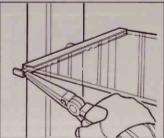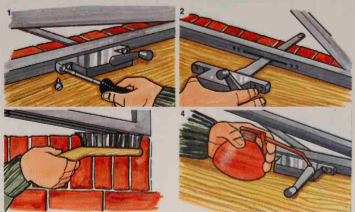Contents
House Window Repairs – How to Instructions
Whether a window is wood, vinyl or aluminum, the material expands and contracts with temperature changes creating problems that can be corrected with a minimum amount of work.
Windows are available in several different types You’ll find wood, aluminum, vinyl and steel windows, in a style range of double hung, casement, sliding, awning and jalousie.
Double-hung windows have an upper and lower sash that operate on a system of weights, springs, chains or cords. The lower sash moves up and the upper sash can sometimes be moved down.
On a casement window, the sash swings out from the frame on hinges attached to one side of the sash. Most are operated with a crank attached to the windowsill.
On sliding windows, the sashes move from side to side on a track or on rollers.
Awning windows are hinged at the top and swing out from the bottom, usually with the aid of a crank attached to the windowsill.
Jalousie windows are glass-louvred windows where each piece of glass pivots on a pin. The glass louvres are opened and closed by a crank handle on the windowsill.
Wood windows, while traditional and in some styles arguably the most beautiful windows, also require the most upkeep. The wood needs to be painted regularly; the sashes can warp in their frames; and the wood s subject to rot
Aluminum and vinyl windows also expand and contract with temperature changes but are of long-lasting materials that require minimum maintenance.
Steel windows need upkeep because they’re prone to rust.
Double-hung Window Repairs
Since most double-hung windows are wood, one of the major problems with this type of window is sticking caused by a buildup of paint.
To correct the problem, work a putty knife around the sash and the stop molding to loosen the paint seal. Use a chisel to remove lumps of paint and work a pry bar under the bottom of the window to try to force the window up.
Once the window is open, sand the stop molding and parting strip to remove the paint from the sliding edges, and then lubricate the moldings with some paraffin wax or spray silicone.
If the window is stuck in the open position, place a wood block on the too edge of the sash and hammer the window down gently, working the wood block and hammer over the entire too edge of the sash. Then remove the excess paint from the top part of the window frame, sand and lubricate the moldings. Work the window up and down a few times so you’ll have an even, thin coating of lubricant.
Expansion of a wood window due to humidity can cause the window to become immovable. The problem can be corrected by removing the top molding with a chisel and a hammer, making sure you don’t damage the molding. Then sand the sash without removing t from the frame. Lightly tack the stop molding in place and test the window. If it still sticks, try tapping the grooves in the window frame with a wood bIock and a hammer to force the frame slightly outward. If this fails, you’ll have to remove the sash and plane the edges of the sash, stop molding and parting strip.
Remove the sash by taking out the stop molding and parting strip. Pull gently on the sash to remove it from the frame, remove the sash cords, then lift out the sash for planing.
Plane and test-fit until you’ve restored the window to its original shape.
A common malfunction of the doublehung window is a broken sash cord or chain. The cord allows the sash to be opened and closed properly. With a broken cord, the window will do neither.
You’ll need to remove the sash and sash cord to make the repair Remove the screws from the sash-weight pocket cover in the window frame and remove the sash weight. If cord is currently used on your windows, it’s best to replace it with a chain. Chain will last longer than cord, reducing your chances of future repair.
Thread one end of the chain through the pulley to the sash weight, then tighten the chain securely to the weight. Put the weight back into its opening. Grab the chain at the pulley and raise the weight until it touches the pulley. Secure the chain so the weight will stay in place, then screw the chain into position in the sash groove, using wood screws through the chain links. Replace the sash-weight pocket cover and replace the sash.
Some windows will not have a sash-weight pocket cover, and you’ll need to remove the window frame to get at the sash weight.
Many modern double-hung windows, particularly aluminum and vinyl windows, have spring-lift sash windows. An aluminum tube runs down the sash channel and inside the tube there’s a spring around a twisted rod. The spring is kept taut by the rod, enabling the sash to remain open in any position and allowing movement of the window with only slight pressure.
If you’re experiencing difficulty with window movement, you may just need to adjust the spring tension. Remove the screw from the tube, making sure you hold the tube and the screw firmly so that the spring won’t completely unwind. Adjust the spring a few turns in either direction to compensate for your problem — if the window doesn’t rise properly, the spring needs tightening; if it won’t close properly, loosen the spring. Again, make sure both the tube and the screw are held firmly. Reattach the tube and test your window.
Repairing casement Window Repairs
Repairs to wooden casement windows usually involve tightening loose hinges and cleaning the crank handle. If the window doesn’t close properly, it could mean loose hinges. If the holes are too loose to accept the screws, remove the hinge leaf, drill 6mm (1/4in) holes where the screw holes are located and fill the holes with a 6mm (1/4in) dowel. Make sure the fit is tight. You can then reattach the hinge leaf.
Sometimes swollen wood will prevent the windows from closing. Plane the window slightly to fit. Remember that swollen wood will usually shrink in drier weather and if too much wood is removed, there could be a gap between the window and frame after the wood shrinks.
The crank handle needs lubricating from time to time to compensate for dirt build-up in the mechanism. Apply a silicone spray and light oil to the crank works for ease of operation.
If the crank doesn’t work, the gears may be broken. Loosen the set screw and remove the handle of the crank, then remove the housing screws. Slide the arm until it leaves the window track. Replace the gears in the housing if they’re broken, or clean the debris from around the gears if they’re just not operating efficiently. Replace the mechanism.
Repairing casement Window Repairs step-by-step
To remedy a problem in the gears of a casement window (1) remove the mechanism by unscrewing the bolts that hold it to the frame; (2) slide the arm free of the window track and adjust or replace gear mechanism; (3) using a brush, clean the debris from around the window track then reapply the gear box; (4) oil the handle and hinges once a year
Repairing sliding windows

Sliding windows move along a track at the top and bottom. Most are made of aluminum and require little in the way of repair.

A slider that sticks can be corrected by lubricating the tracks with some paraffin wax. If the track is bent, re-form it using a wood block and a hammer.
Awning and jalousie windows

Both these windows operate on the same principle — the glass swings out from the bottom on hinges (awning windows) or Pivots (jalousies) to provide for ventilation as well as keeping rain out of the house.

Repairs to both these window types usually involve simply regular lubrication of the pivots or crank handles and a tightening of the hinge screws.


